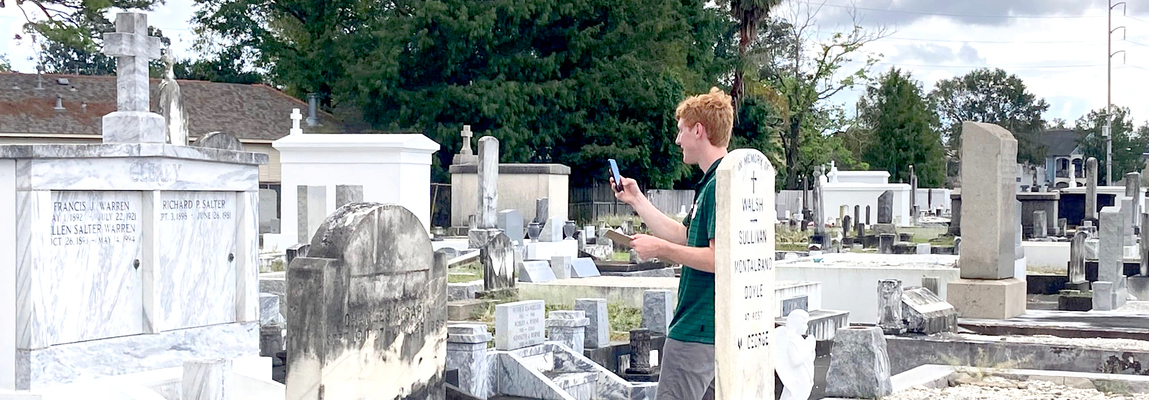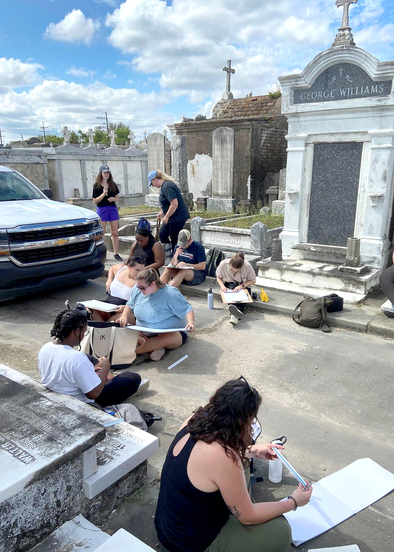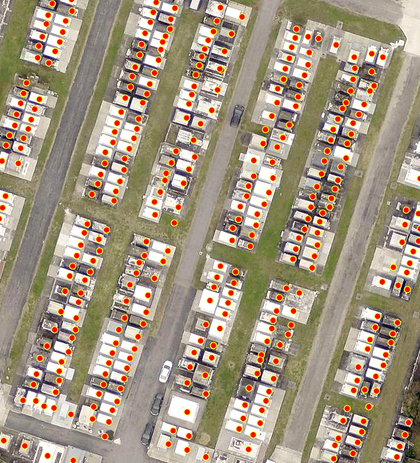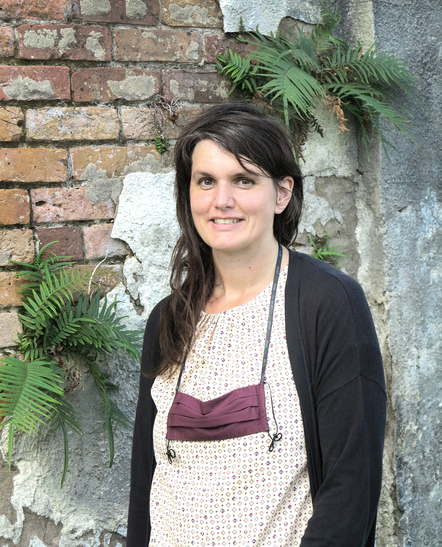Maps to offer ‘21st-century’ handle on Catholic cemeteries
-
 Above: A student-volunteer from Tulane University helps New Orleans Catholic Cemeteries collect and enter data on St. Patrick Cemetery No. 1 on Canal Street, one of NOCC’s historic burial grounds. (Photo courtesy of New Orleans Catholic Cemeteries)
Above: A student-volunteer from Tulane University helps New Orleans Catholic Cemeteries collect and enter data on St. Patrick Cemetery No. 1 on Canal Street, one of NOCC’s historic burial grounds. (Photo courtesy of New Orleans Catholic Cemeteries)
By BETH DONZE
Clarion Herald
An ongoing effort to digitally map all 13 historic burial grounds managed and operated by New Orleans Catholic Cemeteries (NOCC) ultimately will enable members of the public to locate a tomb of interest and access a wealth of information on it from the convenience of their smartphone or computer screen.
To date, digital mapping has been completed on every tomb inside 198-year-old St. Louis Cemetery No. 2 (300 N. Claiborne Ave.), a cemetery of nearly 1,500 tombs; 579 of the 3,339 tombs at St. Louis Cemetery No. 3 (3421 Esplanade Ave.); 922 of the 2,200 tombs at St. Patrick Cemetery No. 1 (5000 Canal St.); and 155 of the approximately 650 tombs at St. Patrick Cemetery No. 2, also in the 5000 block of Canal Street.
 On Oct. 22, master’s degree students enrolled in Tulane University School of Architecture’s preservation studies program began assisting NOCC with the latest phase of the digital mapping endeavor by focusing their efforts on a fifth site: St. Joseph Cemetery No. 1 (2220 Washington Ave.), which contains about 1,400 tombs.
On Oct. 22, master’s degree students enrolled in Tulane University School of Architecture’s preservation studies program began assisting NOCC with the latest phase of the digital mapping endeavor by focusing their efforts on a fifth site: St. Joseph Cemetery No. 1 (2220 Washington Ave.), which contains about 1,400 tombs.
“I think it’s going to be a game changer for us,” said Heather Veneziano, NOCC’s director of public engagement and development. Veneziano, who single-handedly completed the digital mapping of St. Louis No. 2 using survey software she built herself “from the ground up,” said the mapping is tailored to the unique landscapes within New Orleans’ Catholic burial grounds.
Navigational ease
“There is cemetery mapping software out there, but it’s mainly for the traditional American cemetery of in-ground graves, with very few burials within each plot, so it didn’t suit our needs,” Veneziano explained. “(New Orleans’ cemeteries) have thousands of little buildings – we don’t have just headstones. So, coming up with a solution to digitally map our unique landscapes was a bit of a challenge.”
Once available online, the database will allow users to locate a tomb of interest on a digital map and call up a raft of written and photographic information on it – everything from the type of the tomb, to its address inside the cemetery, to closeup images of all of its tablets. The digital maps will be a far cry from having to consult decades-old paper maps to find a tomb – schematics which provide an overhead view of the cemetery and the little squares indicating each tomb, but are often difficult or impossible to read, Veneziano said.
 “I think the digital maps are going to be super helpful to our staff,” Veneziano said. “We get a lot of requests from people calling us up and wondering where their family tomb is. We do the best we can to give them directions – ‘Go down St. Anthony’s Aisle and take a left,’ or ‘It’s Tomb No. 5, Section 13.’ Most people don’t know what that means. Even when we show them the paper map, it can still be confusing. So being able to locate the tomb digitally just makes it really easy for the public and for our staff.”
“I think the digital maps are going to be super helpful to our staff,” Veneziano said. “We get a lot of requests from people calling us up and wondering where their family tomb is. We do the best we can to give them directions – ‘Go down St. Anthony’s Aisle and take a left,’ or ‘It’s Tomb No. 5, Section 13.’ Most people don’t know what that means. Even when we show them the paper map, it can still be confusing. So being able to locate the tomb digitally just makes it really easy for the public and for our staff.”
First up: St. Louis No. 2
With the enthusiastic support of NOCC’s executive director, Sherri Peppo, Veneziano began mapping St. Louis Cemetery No. 2 last year, tackling it first because it was in the greatest need of restoration among the 13 NOCC sites. Veneziano, who holds master’s degrees in fine art and preservation studies, was already in the midst of conducting a thorough condition assessment of every tomb at 1823-established St. Louis No. 2 for the twin purposes of historical documentation and as a way to inform future preservation efforts at the site.
Because of that extra attention, the digital maps of St. Louis No. 2 will be more in depth than those related to the other 12 cemeteries, offering such details as the materials used in each tomb’s construction and its “condition rating,” based on a numerical scale from “1” (imminent danger of collapse) to “5” (structurally stable, with all finishes intact).
“That cemetery is older, too, so there are very few tombs in there that have perpetual care; there aren’t many current ownership records for St. Louis No. 2,” said Veneziano, who asked Amanda Walker, the administrative specialist for New Orleans Catholic Cemeteries, to sift through property records related to the site and to identify tombs that had no current title holder on file. This information eventually will be layered onto the digital map, Veneziano said.
“So, ultimately our staff will be able to pull up ‘Square One’ of St. Louis No. 2 (for example) and see that a certain percentage of those tombs are abandoned,” she said. “This will be useful information in the future to prioritize repairs and apply for grants. It’s going to be really nice to have the information so readily available for our staff and also for the public, for things such as genealogical research.”
A massive undertaking
Over at St. Louis Cemetery No. 3 near Bayou St. John, Laurel M. Fay, a graduate student with Tulane’s preservation studies program, completed digital mapping work on a whopping 500 tombs during a 12-week period last summer. Fay received a small stipend for her work, which was part of her compulsory practicum project for graduation. Charlotte Smith, a summer intern for Save Our Cemeteries, a graduate of Yale University and a current architecture student at Cambridge University in Britain, digitally mapped an additional 79 tombs at St. Louis No. 3.
“St. Louis No. 3 is our most active cemetery,” Peppo said. “We get the most burials in that cemetery, so we thought it would be most helpful to our staff to have it digitally mapped early on.”
 At St. Patrick Cemetery No. 2, Smith and two other volunteers used Veneziano’s mapping app to geo-tag and record information on tombs there: Juliette Hotard, Save Our Cemeteries’ volunteer and restoration coordinator; and Lynn Davis, a long-time cemetery preservationist.
At St. Patrick Cemetery No. 2, Smith and two other volunteers used Veneziano’s mapping app to geo-tag and record information on tombs there: Juliette Hotard, Save Our Cemeteries’ volunteer and restoration coordinator; and Lynn Davis, a long-time cemetery preservationist.
Volunteers also are assisting digital mapping efforts at St. Patrick Cemetery No. 1 – Tulane undergraduates enrolled in Dr. Laura Kelley’s “Irish in New Orleans” service-learning course.
“That class has been using St. Patrick No. 1 as a laboratory for the last few years for other projects, but this year Dr. Kelley allowed her students to help us with the digital mapping,” Veneziano said.
Fingertip information
Tomb-related details being entered into the digital mapping database include:
• The tomb’s street address within the cemetery, along with its section and lot number
• Plot size (single, double or larger)
• Tomb type (family tomb, coping tomb, grass-only, mausoleum vault, columbarium niche, society tomb, religious order tomb, etc.)
• If there is a full or partial metal fence at the tomb or evidence that one existed in the past
• Information culled from the tomb’s tablature, including what language the inscription is in. Veneziano and her fellow mappers have encountered French, German, Latin, Greek and even Croatian in their surveys. The bottom-right corner of the tablet sometimes will include the name or initials of the tomb’s architect, builder or stone carver – information that will be recorded in the digital database, where applicable.
• The family name inscribed on the tomb (additional individuals buried in the tomb will be added to the database at a future date, Veneziano said.)
• If the tomb has a perpetual care marker. “This is going to be very helpful in the future for our staff, because we’ll be able to pull up the map and see every single location of perpetual care within our cemeteries,” Veneziano said. “So, when we have to go out and do perpetual care work and put it on the (maintenance) schedule, we’ll be able to have it pop up.”
• If the tomb has a military marker, and if so, the name of the military branch and/or battle in which the decedent served. “This will be helpful information to know for Memorial Day events, flag ceremonies – anything we do to honor our veterans,” Veneziano said.

Creating partnerships
Although not yet available to the public, the database ultimately will be accessible through a link posted on NOCC’s website, nolacatholiccemeteries.org. The agency currently offers 360-degree virtual tours of all 13 of its burial sites that allow users to “walk” through the cemeteries using a technology similar to Google Street View; however, the ongoing digital mapping project is the first time tomb data is being collected so comprehensively and systematically, Veneziano said.
The flexibility of the software also will permit users to enter additional information on a given tomb, for example, photos of the individuals interred there, Veneziano said.
“Some information will be able to be viewed by the public on the website, and some information will be confidential – available to staff only,” she said.
Another exciting outcome of the mapping project is the working relationships NOCC has established with Tulane and organizations such as Save Our Cemeteries. Tulane graduate students specializing in historic preservation recently began digitally mapping 1854-established St. Joseph Cemetery No. 1 on Washington Avenue, a project that will have them doing tomb research, architectural drawings, drone photography and condition assessments.
Every hour NOCC staff and its trained volunteers give to the project helps, given the work required to digitally map the combined 100 acres of the 13 Catholic cemeteries, Veneziano said.
“Tulane has committed to this being an ongoing relationship, so every year they’ll help us with another cemetery,” she said. “Our staff has worked especially hard this year – both in responding to the pandemic, and in dealing with the aftermath of Ida. Many of our field and office staff went above and beyond to accommodate property owners and ensure that the cemeteries remained in good condition. I’m really proud of everyone’s work. So often, big projects get attention and the day-to-day gets overlooked, but really it is the day-to-day operations that make our ministry.”
New Orleans Catholic Cemeteries is trying to locate as many title holders of its historic tombs as possible. If your family has not had an interment for the last 30 years, but has a title to a tomb located in one of the 13 Catholic cemeteries, please email [email protected] to update your contact information.
[email protected]
